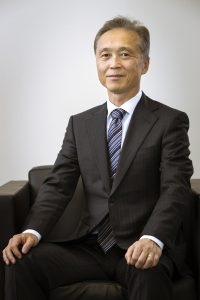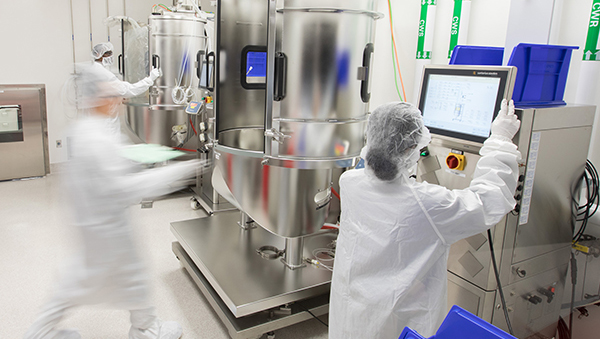The appointment of a new CEO by Astellas Pharma—Japan’s fourth largest pharma company—is unlikely to slow down its development of gene therapies—efforts boosted by the recent lifting of a clinical hold affecting one lead candidate but hindered by a continuing hold impacting the other, in a trial in which four patients have died.

Naoki Okamura, a 37-year Astellas veteran, is being promoted from corporate executive vice president and chief strategy officer to president and CEO, where he will succeed Kenji Yasukawa, PhD, effective April 1. Yasukawa, who will become chairman, is stepping down after five years as CEO, during which he reversed a revenue decline, navigated the “patent cliff” loss of exclusivity to several top-selling drugs, and overhauled Astellas’ approach to drug development.
Yasukawa oversaw Astellas’ shift from creating products focused on specific diseases to a “Focus Area approach,” in which the company has prioritized investment around five “primary focus” areas. In its Corporate Strategic Plan 2021 (CSP2021), setting priorities through the 2025 fiscal year, Astellas included among its focus areas “genetic regulation,” through which the company committed to discovering, developing, and delivering “meaningful” gene-based therapies for patients with genetic diseases.
Yasukawa moved to advance gene therapy development by launching its Astellas Gene Therapies Center of Excellence, with the aim of building a portfolio of adeno-associated virus (AAV)-delivered gene therapies to treat rare neuromuscular and central nervous system (CNS) diseases.
“Management policy and the direction of the business will, in principle, remain unchanged,” Okamura said February 6, addressing reporters in Japan. “Astellas is committed to creating drugs that do not just reduce symptoms, but that can also significantly improve the root cause of the diseases, as with cell therapy and gene therapy.”
Okamura joined Astellas in 1986 and has held a series of executive positions that have included licensing and alliances, corporate planning, and chief business officer, before being named to his current position last year.
Accelerating development
“The appointment of Naoki Okamura as Astellas’ next CEO ensures the organization is best placed to achieve the goals set out in CSP2021, including our commitment to accelerate the development of potentially transformative gene therapies and other novel technologies,”
Richard Wilson, senior vice president, primary focus lead of genetic regulation with Astellas Gene Therapies, told GEN Edge recently. “I have seen firsthand his motivational leadership approach and commitment to enhancing Astellas’ ability to deliver value for patients.”
Astellas’ most advanced gene therapies are:
- AT845, a Phase I/II gene replacement therapy for adult late-onset Pompe disease caused by mutations in the gene encoding the lysosomal enzyme alpha-glucosidase (GAA). AT845 uses an AAV serotype 8 (AAV8) vector under a muscle-specific promotor to deliver a functional copy of GAA.
- Resamirigene bilparvovec (AT132), a Phase II gene replacement therapy for X-linked myotubular myopathy (XLMTM), consisting of an AAV8 vector containing a functional copy of the MTM1 gene, to transfect and express myotubularin in skeletal muscle cells.

Last month, the FDA lifted a seven-month clinical hold on Astellas’ Phase I/II FORTIS trial (NCT04174105) assessing AT845. The agency placed the hold after one trial participant developed peripheral sensory neuropathy, a serious adverse event (SAE). The SAE was classified by a site investigator as Grade 1 (mild in severity) but deemed serious due to medical significance.
FORTIS has yet to fully resume, Wilson said.
“We’ve started the activities towards resuming the study. But there’s a lot of mileposts along the way to getting that done, including revising the protocol, getting that through the institutional review boards, after getting a final sign off within Astellas, getting the final version of that through the FDA. And then there’s a whole bunch of site startup activities that need to occur,” Wilson explained.
Starting the journey
“We’ve started that journey, but it will be several months until we expect to see the study resumed, which is consistent with other gene therapy companies coming off of holds.”
Astellas and Selecta have not disclosed their timeframe for reading out data from the FORTIS trial.
Wilson said the clinical hold did not delay a collaboration launched last month through which Astellas agreed to license IdeXork (Xork) from Selecta Biosciences for study as a potential next-generation immunoglobulin G (IgG) protease for use with AT845. Astellas agreed to pay Selecta $10 million upfront, up to $340 million tied to achieving development and commercial milestones, plus royalties on any potential commercial sales where Xork is used as a pre-treatment for AT845.
“What we particularly liked about the Xork opportunity was, it’s derived from a bacteria and enzyme that doesn’t tend to affect humans,” Wilson explained. “We think that Selecta has this nice balance of a product in Xork that has a low probability of having pre-existing immunity to the protease, which is designed to solve the problem of pre-existing immunity to the AAV.”
Selecta is responsible for development and manufacturing of Xork, and would maintain the rights for development of additional indications. Will success in Pompe lead Astellas to expand this into other diseases?
“It’s certainly an option we would think about,” Wilson said. “We’re using Pompe very much as the proof of principle here.”
By contrast, Astellas remains in its second FDA clinical hold for the Phase II trial of its other clinical phase gene therapy, resamirigene bilparvovec.
The first clinical hold on the Phase I/II ASPIRO trial (NCT03199469) was imposed in 2020 after the company acknowledged the deaths of three boys who received the higher of two doses (3.5×1014 vg/kg) before they started to demonstrate signs of liver dysfunction within three to four weeks after dosing.
The FDA imposed a second clinical hold on ASPIRO in September 2021 after Astellas acknowledged the death of a fourth boy. Unlike the other three boys who died, the fourth was dosed at the trial’s lower dose of 1.3×1014 vg/kg.

Addressing analysts on its quarterly conference call earlier this month, Astellas disclosed that it had submitted initial clinical hold responses to the FDA and European Medicines Agency (EMA) during the third quarter of its 2022 fiscal year (October-December 2022).
That submission was followed by “productive agency interactions” that included an FDA Type B meeting and an EMA PRIME meeting, both in November.
Constructive discussions
“We have had constructive discussions with the United States and the European authorities, and we plan to continue to do discussions with them in Q4 [January-March 2023],” Astellas CFO Minoru Kikuoka said. “We will update our overall plan based on feedback from the authorities.”
“At this point, we expect to resume dosing in FY2024 or later,” Kikuoka added, referring to the fiscal year that begins April 1, 2024.
Wilson said Astellas will not furnish details on the progress it has made with regulators, since the discussions are ongoing.
He said the company has made progress, however, in addressing the three challenges disclosed by former chief medical officer Bernhardt Zeiher, MD, during Astellas’ R&D Meeting in March 2022.
One was explaining the hepatic cholestatic syndrome that the company saw in the four XLMTM patients who died in the absence of any prior preclinical signal for any of these events. Investigation by researchers in and outside Astellas found that intrahepatic cholestasis was part of the natural history of XLMTM, and that bile salt export pump protein (BSEP), a major mechanism for bile acid export from hepatocytes, was missing in the four boys who died.
Mutations in the gene encoding BSEP caused one form of progressive familial intrahepatic cholestasis (PFIC), which showed very similar histopathologic and laboratory features to those seen in the four boys who died.
“We hypothesized that the absence of BSEP played a key role in the pathophysiology of cholestasis and liver failure in these participants. But we do not currently understand what about XLMTM and AT132 may have led to the disappearance of BSEP in these individuals,” Zeiher said.
Astellas’s second challenge, Wilson said, has been changing the ASPIRO trial protocol and patient inclusion criteria, to minimize the chance of enrolling patients with a predisposition to developing cholestatic syndrome. The third challenge was further removing empty capsids that lack the vector genome and thus cannot provide a therapeutic benefit—a manufacturing change that will reduce the overall dose of AAV capsids delivered to each participant.
“Those kinds of manufacturing changes take months to years to roll through as you go through engineering and GMP manufacturing, and then submission of data to the FDA,” Wilson said. “Stay tuned for more updates as we move into fiscal ‘23.”
Proof of concept
Resamirigene bilparvovec and AT845 are two of four Astellas gene therapy candidates which have the potential to show proof of concept by the end of Astellas’ fiscal year 2025, which starts April 1 of that year. The company has not disclosed the other two candidates.
Both AT845 and resamirigene bilparvovec came to Astellas through its $3 billion acquisition of Audentes Therapeutics, completed in January 2020. At the time, resamirigene bilparvovec was the lead pipeline program of Audentes, which Astellas transformed into Astellas Gene Therapies.
Astellas has disclosed more than a dozen mostly preclinical and discovery phase gene therapy candidates, including:
- AT808, a gene replacement therapy for Friedreich’s Ataxia targeting the FXN gene, in preclinical phase.
- Two muscle disease candidates that Astellas is developing with Modalis Therapeutics, MDL-201 and MDL-202. Both are in “nonclinical and IND-enabling studies” and “CMC [chemistry, manufacturing, and controls] activities” Modalis stated in its presentation of 2022 results February 13, though Astellas has not disclosed the status or mechanisms for either.
- AT466, a vectorized, exon skipping / vectorized RNA knockdown for the DMPK gene, targeting myotonic dystrophy, in discovery phase. https://www.astellasgenetherapies.com/myotonic-dystrophy-type-1
- A program to treat Angelman Syndrome by restoring the UBE3A gene, in discovery phase
Other gene therapy candidates disclosed by Astellas:
- ASP1015, a glaucoma gene therapy it inherited when it acquired Quethera in 2018, for which an IND has been planned for 2024.
- Programs to develop a gene therapy for dry age-related macular degeneration (dry AMD) and other macular degeneration indications, being developed in collaboration with University of Pittsburgh.
Astellas has options for exclusive licenses on two other gene therapy candidates after investing $50 million to take a 15% stake in their developer, Dallas-based Taysha Gene Therapies—Taysha’s lead candidate TSHA-120, a giant axonal neuropathy (GAN) candidate now in an ongoing Phase I/II clinical trial (NCT02362438); and TSHA-102, a treatment for Rett syndrome now under study in a Phase I/II trial in adult Rett syndrome (NCT05606614).
TSHA-102 is a self-complementary intrathecally delivered AAV serotype 9 (AAV9) gene replacement therapy, and the first-and-only gene therapy for Rett syndrome to have reached the clinic. TSHA-120 is an intrathecally dosed AAV9 gene replacement therapy delivering the gigaxonin gene to treat GAN.
“Interesting science”
Taysha recently acknowledged it could not fulfill its earlier expectation of FDA approval late this year or early next for TSHA-120, after the agency recommended a placebo-controlled randomized clinical trial that the company says is beyond its means. In response, seven analysts cut their 12-month price targets on Taysha shares, which tumbled 26% on the news.
Watching developments closely is Astellas, whose investment gives it a right of first refusal to acquire Taysha.
“We saw some interesting science in what they’d done. We appreciate what they’ve done with intrathecal delivery of AAV9. We felt it was quite complimentary to a lot of what we’ve been doing with AAV8,” Wilson said. “In the event that we were to take over their (Taysha’s) programs, it would be relatively straightforward for us to take their manufacturing technology and conduct it in our Sanford (NC) facility.”
Sanford is where Astellas Gene Therapies last year opened a $100-million late-stage clinical and commercial manufacturing facility, the company’s third devoted to producing gene therapies. The others are in Tsukuba, Japan, 45 miles northeast of Astellas’ headquarters in Tokyo, and South San Francisco, CA.
“If we find we’re doing a lot of high-volume manufacturing, we can continue to build out the Sanford site by expanding within that shell. It’s a very convenient way to ramp up if we need to,” Wilson said.
Ramping up, he said, will also entail investing in technologies that help improve throughput and efficiency, “so that for a given unit of a manufacturing, you’ll be able to get a bigger number of doses out in the future.
“But from a very kind of gross level, we feel like we have the capacity we’ll need within the same footprint for the foreseeable future,” Wilson added.





